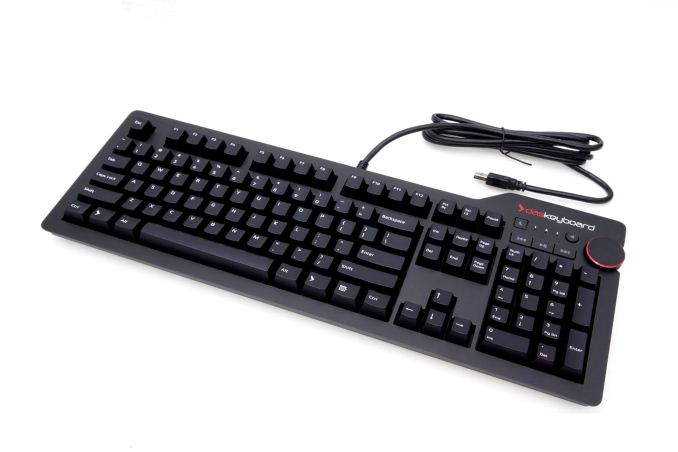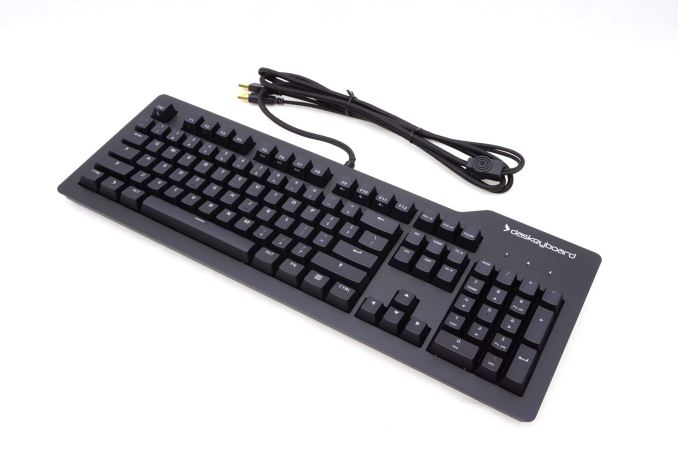The Das Keyboard 'Prime 13' & '4 Professional' Mechanical Keyboard Review
by E. Fylladitakis on January 10, 2017 8:00 AM ESTConclusion
In this review we had a look at the new Das Keyboard Prime 13 and the popular Das Keyboard 4 Professional. The keyboards do share a similar appearance and the same quality mechanical switches from Cherry but, to our eyes, each keyboard is targeted towards an entirely different group of users.
The Das Keyboard 4 Professional is a mechanical keyboard that has been clearly designed with professional users in mind, with the company forthrightly marketing it as such a product. Conscious professionals need devices that are aesthetically elegant, productive and durable. We cannot claim that the Das Keyboard 4 Professional will increase your productivity any more than any other similar mechanical keyboard, yet we can state with certainty that it is a very high quality product that will easily last a decade of heavy daily use. The USB 3.0 hub is a useful thing to have, especially in an office environment where devices like flash drives are frequently used.
With its intended primary target group being conscious professionals and office workers, we feel that the Das Keyboard 4 Professional is a perfect match for a modern workspace. We can only negatively comment the lack of programmability, which will be an issue for certain categories of professionals. For example, programmers tend to reprogram certain keys to insert ready, frequently repeating code and CAD users to perform certain repetitive functions. It is an expensive product, yet not overly so for a top tier professional keyboard. Its primary competition is primarily coming from the Cherry MX Board 6.0, a slightly more expensive professional keyboard with backlighting, but also lacks the sound volume knob and the USB 3.0 hub.
A quick glance can easily lead someone to the conclusion that the Das Keyboard Prime 13 is practically the same keyboard as the Das Keyboard 4 Professional, but that would not be a very accurate statement. The company still markets the Prime 13 as a keyboard to "get the job done", hinting that professionals still are a focus group of this keyboard. However, the marketing phrasing and the changes from the Das Keyboard 4 Professional hint that the company is trying to target a wider audience. This becomes clear when one notices that the company is trading features that can be of use in a strictly professional environment (the USB 3.0 hub, the extra buttons, and even the ruler) with LED backlighting, a feature that is generally found appealing by gamers and home users. The inclusion of the keycap puller and the use of Cherry cross-type stabilizers also hints that the designer intended for the user to be capable of removing/replacing the keycaps, something clearly not taken into account during the design of the Das Keyboard 4 Professional.
In our opinion, the Das Keyboard Prime 13 is having a bit of an identity crisis. Due to the proximity of its price to the Das Keyboard 4 Professional, a professional user would almost certainly buy the 4 Professional instead. For home users and gamers, the Prime 13 may be a keyboard of outstanding quality, yet there are several competitive products based on Cherry MX switches, with backlighting, that sell for less than $150. Many of them are offering features useful for gamers, such as extra macro keys and full-layout programmability, which the Prime 13 is lacking. The Das Keyboard Prime 13 could become an excellent choice for users that want a very high quality keyboard for their all-around home PCs, especially for professionals that work from home, but lower retail prices are needed to make it a truly competitive product.












58 Comments
View All Comments
Zan Lynx - Wednesday, January 11, 2017 - link
I noticed a thing in the article that I missed before. The author wrote, "programmers tend to reprogram certain keys to insert ready, frequently repeating code" and I have to say, "No, we don't."We have editors for that. Programmable editors, because we are programmers. Java editors like Eclipse get extensions in Java. Atom in Javascript. Emacs in elisp, VIM in vimscript, LUA or Python. Etc.
No one bothers writing macros for their keyboard. That would be incredibly limiting and a dumb idea.
E.Fyll - Wednesday, January 11, 2017 - link
Well, you don't actually need to write a macro if the software allows you to just copy-paste your code into it. :)Depending on what exactly that is you do, sure you can be using macros to insert common, repeating commands and very efficiently so. I know quite a few people who do that myself. No matter how good the editor is, the code is not going to write itself. For example, Eclipse will create your packages and classes, but it won't start adding things like fields, declarations and strings. Why type "//fields - private field 1/2/3/4...X" when you can just insert it and then just type the field names, then do the same with Constructors and CTRL+Space your way through the code from then on? Unless if Eclipse got a lot smarter since I last used it, and that was several years ago, you certainly need to start typing a lot of repetitive commands when you need to program something.
Programming aside, I even do it when I expect a piece of text, even if it is just a name or cell code, to repeat itself many times in whatever what I'm working on is. I just insert it as a macro by pasting it into the keyboard's software and then just press that button whenever I need to.
Do not mistake that with having the keyboard insert huge chunks of text/code for you; well, at least not if you don't have some weird repeating template that you work on all the time for some very strange reason.
E.Fyll - Wednesday, January 11, 2017 - link
"...in whatever what I'm working on is."And I'm not even drunk.
"...in whatever I'm working on."
Wolfpup - Wednesday, January 11, 2017 - link
Thanks for the review! I've been using mechanical keyboards for some years now, thanks to this site, as the membrane keyboards kept getting worse and worse by the year.I like that Das Keyboard has media controls on their keyboards now-that was the one thing preventing me from buying one before.
I've only used Cherry MX Brown, so it's possible I'd like something else better, but I like them a lot and don't plan on ever using a keyboard that doesn't use Cherry MX.
I'll definitely look at Das Keyboard next time I buy! (Among other things, I've got two Razer keyboards, but they switched from Cherry MX to some offbrand thing they of course claim is better, so I'm done with Razer...)
FunBunny2 - Thursday, January 12, 2017 - link
one note on mechanical keyboards, particularly the Model M and current clones. the M is a membrane keyboard, meaning you have to bottom the key to get the character. Cherry type switches don't require full stroke, and are sometimes credited with being easier on the hands. I worked on Ms for years, and then membranes when I had to. I'm typing on a Das and have been for some years, and still haven't lost the habit of bottoming the stroke.oneoff - Friday, January 13, 2017 - link
The Model M is most assuredly NOT a membrane keyboard.It is an ancient design that uses buckling springs.
FunBunny2 - Saturday, January 14, 2017 - link
-- The Model M is most assuredly NOT a membrane keyboard.it absolutely is. the buckling spring is just the actuation. the "switch" is embedded in a membrane at the bottom: https://en.wikipedia.org/wiki/Model_M_keyboard#Des...
note the animated little thingee on the right.
helvete - Tuesday, February 7, 2017 - link
"This can be very handy for quickly putting a PC to sleep/lock and then waking it up from the keyboard without having to reach for the tower..."I don't see this as an advantage, because:
- you can always set up "Power on by keyboard" settings in BIOS
- and it is _very_ inconvenient to hit a key like this by accident